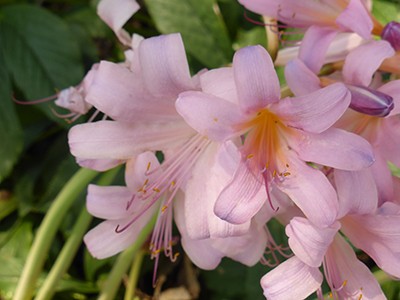Plants of the Week: August 17
Helianthus ‘Sunshine Daydream’
A dazzling bright yellow color and intriguing texture make the Helianthus ‘Sunshine Daydream’ a must-see. As you walk along the pathway by the Biostream, you will notice the distinctive flower pattern and double blooms of this herbaceous summer perennial which flowers continuously from June to August. Native to North America, it is a branch sport of ‘Capenoch Star’ and looks similar to a dahlia. Not only are the flowers fantastic for cutting, but also for attracting butterflies and bees. In addition to its stunning appearance, Helianthus ‘Sunshine Daydream’ is hearty in the summer heat and is mildew resistant. Photo Credit: L. Lancaster
Relax in one of the iconic white wooden Swarthmore campus chairs and experience the magic of these Magill Walk wonders! The Lycoris squamigera flowers are beautiful, as well as mystical. Did you know that plants in the Lycoris genus are commonly referred to as resurrection flower, surprise lily, or magic lily? This is because the leaves disappear in the summer and flowers emerge from the stem in August. Easy to maintain, Lycoris squamigera is one of the most cold-hardy species of lycoris available on the market; it needs only moderate water during the summer after the leaves die and before the stems rise. The bloom duration is only a few weeks, so be sure to see this charming plant as it blooms soon. Photo Credit: L. Lancaster
Alocasia ‘Polly’
Alocasia ‘Polly’ also known as elephant ear is an impressive indoor or outdoor plant with a refreshing tropical vibe. Its prominent white veins make the foliage look like an arrowhead. Although this plant is a fascinating treasure in the Scott Entrance Garden, it is extremely challenging to grow and will quickly die if it is not cared for properly. Ideal conditions are filtered to full shade, warm temperatures year-round, high humidity, and moist soil. Gardeners, beware that the consumption of the plant is poisonous for cats and dogs (and most pets). While Alocasia ‘Polly’ may not be the best plant choice for your home, it is certainly a remarkable plant to admire on your next Scott Arboretum visit. Photo Credit: L. Lancaster








No Comments